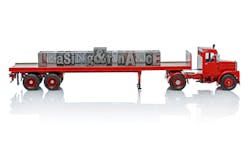The broader economy has rebounded quite well from the severe market turbulence of 2020. Key to this economic rebound are companies with transportation fleets that provide the movement of goods across America. However, many of these firms must make strategic organizational decisions when determining the right procurement strategies to upgrade aging equipment. The costs involved can be significant depending on the type of procurement structure (lease versus purchase), and even as more companies shorten their equipment life cycles through leasing, many are realizing that not all lease agreements are equal.
Companies in a full-service lease (FSL) already know it is not a flexible option. But it is also critical to understand the many costs under an FSL when compared to an unbundled lease (UBL).
Businesses need flexibility for market changes
Entering 2021, federal stimulus measures and pent-up consumer demand resulted in the American economy heating up, forcing many companies to expand operations. Fleets also need to monitor costs as inflationary pressures are increasingly resulting in profit erosion.
A key inflation indicator rose a faster-than-expected 3.1% in April as price pressures built in the rapidly expanding U.S. economy, the Commerce Department reported recently. The core personal consumption expenditures index was forecast to increase 2.9% after rising 1.9% in March.
With flexibility at the forefront of the business strategy of operating a fleet, scrutinizing every detail of a fleet’s vehicle lease structure can mean the difference of millions gained or lost toward the bottom line.
Unfortunately, not all leases are created equal, and some organizations have suffered from an inability to exercise this flexibility through an FSL, which binds them in a lease contract over a specified period.
Full-service leasing defined
In an FSL, the lessor provides financing and other transportation services packaged in a single monthly payment. In an FSL, fleets essentially hand over all decisions affecting the fuel and maintenance costs to their lease provider and focus on a “bundled” monthly payment.
Full-Service leasing eliminates flexibility since it locks the organization into a rigid long-term contract, wherein the cost for maintenance and repair (M&R) and finance are combined along with general overhead costs. Unfortunately, limiting the operational flexibility can be disastrous when business conditions change, or industries experience severe shifts overnight.
Unbundled leasing: Flexibility and competitive costs
In contrast, UBL agreements are designed for fleets to work with a provider that can help break out costs individually and identify the lowest possible costs for operating a fleet.
A UBL offers flexible financing options based on actual costs; not what costs were projected at the onset of the decision process. In a UBL, companies have greater flexibility regarding these individual costs and the freedom to upgrade and scale the size of their fleet, guaranteeing the lowest possible costs involved with truck acquisition.
Cost savings involved when unbundling
The monthly cost savings can be significant. After taking into account the lease payments, warranty, and maintenance fees, an organization pays an average of $1,816.11 per month (unbundled) compared with $2,792.00 per month (FSL). When calculated over a span of 100 trucks, that fleet would experience a first-year savings of approximately $1.2 million toward the bottom line.
These monthly costs are further exemplified when finance costs are considered. Purchase or lease requires a cap cost number and a finance number. The most effective process to reduce the truck and finance costs is to have competitive equipment and finance options. Access to multiple original equipment manufacturers and lenders is key to obtaining the lowest equipment and finance cost. The cumulative per-truck savings over a six-year life cycle amounts to $60,000, or roughly $6 million for a fleet with 100 trucks.
M&R costs differ depending on lease structure
One of the most significant differences between a UBL and FSL is how M&R costs are calculated. M&R is “Front Loaded” in an FSL. Companies can pay a minimum of .07 per mile in year one versus .02 per mile when unbundling. All trucks come with a bumper-to-bumper two-year warranty that can be extended to four years. Expenses for year one include wearable Items (tires, brakes) and Preventive Maintenance. A shorter truck life cycle produces long-term savings beyond the first year. In a UBL, the CPM average equals 5.675 cents over five years. However, in an FSL, fleets pay up to 9 cents per mile.
According to McKinsey and Company, businesses that operate with agility in mind will enjoy a powerful impact on their bottom line, as well as other significant benefits to the organization. This level of agility will not only help companies navigate through today’s unpredictable market but will help position for growth tomorrow.
Katerina Jones is vice president of marketing and business development at Fleet Advantage, a provider of truck fleet business analytics, equipment financing, and lifecycle cost management.
About the Author
Katerina Jones
Katerina Jones is the VP of marketing and business development at Fleet Advantage, a provider of truck fleet business analytics, equipment financing, and lifecycle cost management.
